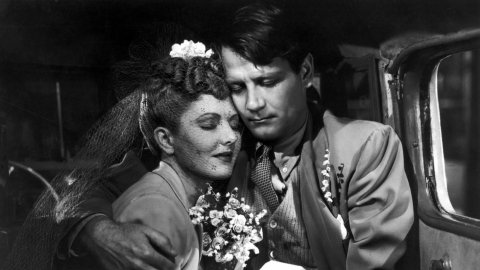
The More the Merrier (1943)
Posted on Fri 10 Sept 2021
Cinema Rediscovered 2021 Film Critics Workshop participant Angela Moore on discovering the sexiest scene in a 1940s Hollywood romantic comedy.
Until now, I believed the sexiest scene in 1940s Hollywood romantic comedy to be Barbara Stanwyck caressing Henry Fonda in The Lady Eve (1941). I now know it to be Joel McCrea and Jean Arthur sitting on a stoop, back late from a date, in The More the Merrier. She’s got a toupee-wearing bureaucrat fiancé, and she keeps talking about him so as to respectably occupy her thoughts and mouth; but she’s also wearing a strapless gown and her hair pinned up, perfectly exposing the canvas of her neck. He kisses it. She falters. Now he holds her neck in his big hand and kisses her on the mouth. She decides to risk it all and takes his handsome face in both hands, kissing him again, hard.
So much of the pleasure of such movies comes from their bottling of the chemistry between two human beings. This scene is made even sweeter by its surprising presence in a charming, quick-witted, sometimes silly comedy. The context is Washington, DC, in wartime, when government expansion solved the job shortage while creating an acute housing shortage. Connie (Jean Arthur) patriotically rents half her flat to a retired millionaire (Charles Coburn), who then rents half his half to Joe (Joel McCrea) and encourages romance between the two. The complications of too many people in too small a space are immediately recognisable to those of us who have done our time in flatshares in expensive cities.
Joe and Connie fall in love slowly, getting to know each other through eating breakfast together, hanging out, and talking through their dividing wall. Connie tells her diary that Joe is “nice to have around”. The gentle way they progress towards that intoxicated and intoxicating moment on the stoop holds even more appeal today, when no one wants to put the time in because a hundred others are just a swipe away. At the same time, their romance is different for the 1940s, too, a more gender-segregated time when such men and women would rarely have lived together before marriage. This, along with the conservative values imposed by the Hays Code, is probably why everyone in these movies seems to fall in love after one day, and get married after two. It’s only the extraordinary beauty of the stars that makes it seem feasible – they could well dazzle you into rapid betrothal.
For this reason, it’s special that the first time Joe sees Connie she has cold cream all over her face. That Jean Arthur was 42 – older than McCrea – when the film was shot, makes Joe’s desire for Connie even hotter. The film keeps telling us there’s eight women to every man (there’s a war on), yet he only wants her. Unlike so many dashing Hollywood-movie sleazebags, he spends the whole film following her rules and respecting her privacy, plus he buys her a monogrammed, genuine-cowhide travelling bag. The film understands, as women instinctively know, that for true, trusting, two-sided sexiness, the ‘mood’ must be set early on.
The More The Merrier screened at Cinema Rediscovered 2021 was restored in 4K by Sony Pictures Entertainment at Cineric, Roundabout West and Prasad laboratories, from the nitrate original negative and the nitrate dupe negative preserved at Library of Congress and BFI National Archive.
Angela Moore
Angela is a half-English, half-Khasi writer living in London. She grew up in Cambridge, studied Sociology at Warwick, and now works for a creative writing charity in London. She has always spent an inordinate amount of time at the cinema – especially when she worked at the BFI and got free tickets.
Angela is particularly interested in old Hollywood and other repertory cinema, but she loves films from all eras and countries. She is drawn to charisma and stardom, conscious artificiality, melodrama, heightened emotions, camp, fashion and style, explorations of identity, music and dance, and cinema that engages all the senses (or seems to). In criticism, she is interested in historical context and re-evaluation, the stories and personalities behind the films, personal responses, and good writing. She believes a bad but interesting film is sometimes better than a serviceable one.
You can read some of her work here and you can find her on the dancefloor or eating pasta, probably.
